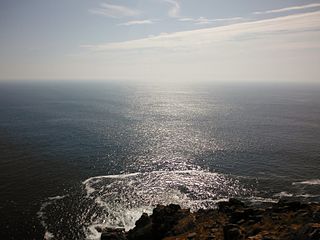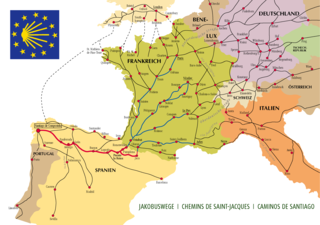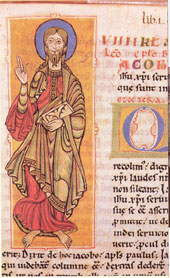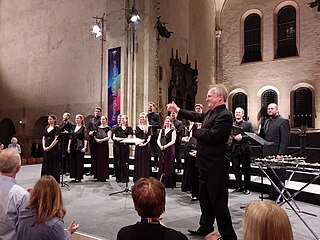
A pilgrimage is a journey to a holy place, which can lead to a personal transformation, after which the pilgrim returns to their daily life.

Cape Finisterre is a rock-bound peninsula on the west coast of Galicia, Spain.

James the Great was one of the Twelve Apostles of Jesus. According to the New Testament, he was the second of the apostles to die, and the first to be martyred. Saint James is the patron saint of Spain and, according to tradition, his remains are held in Santiago de Compostela in Galicia.

The Camino de Santiago, or in English the Way of St. James, is a network of pilgrims' ways or pilgrimages leading to the shrine of the apostle James in the cathedral of Santiago de Compostela in Galicia in northwestern Spain, where tradition holds that the remains of the apostle are buried.

Brandon Wilson is an American explorer and author of non-fiction travel narratives. A fellow of the Explorers Club, he has written books and essays about his extensive travels on foot as a pilgrim. In 2006, he pioneered the Templar Trail, recreating the route of the First Crusade from France to Jerusalem, as a pilgrimage path of peace.

The Codex Calixtinus is a manuscript that is the main witness for the 12th-century Liber Sancti Jacobi, a pseudepigraph attributed to Pope Calixtus II. The principal author or compiler of the Liber is thus referred to as "Pseudo-Calixtus", but is often identified with the French scholar Aymeric Picaud. Its most likely period of compilation is 1138–1145.

The Camino de Santiago, also known as the Way of St. James, extends from different countries of Europe, and even North Africa, on its way to Santiago de Compostela and Finisterre. The local authorities try to restore many of the ancient routes, even those used in a limited period, in the interest of tourism.
The Confraternity of Saint James is a pilgrims' association, educational charity and book publisher for the ancient and modern-day pilgrim route Camino de Santiago or "way of Saint James" to the city of Santiago de Compostela in Galicia in northern Spain.
All the Good Pilgrims is a travel book by Canadian travel writer Robert Ward, published in May 2007 by Thomas Allen Publishers. It relates the author's adventures and encounters on his several journeys along Spain's Camino de Santiago pilgrimage road.

Christianity has a strong tradition of pilgrimages, both to sites relevant to the New Testament narrative and to sites associated with later saints or miracles.

Pilgrim badges are decorations worn by some of those who undertake a Christian pilgrimage to a place considered holy by the Church. They became very popular among Catholics in the later medieval period. Typically made of lead alloy, they were sold as souvenirs at sites of Christian pilgrimage and bear imagery relating to the saint venerated there. The production of pilgrim badges flourished in the Middle Ages in Europe, particularly in the 14th and 15th centuries, but declined after the Protestant Reformation of the mid-16th century. Tens of thousands have been found since the mid-19th century, predominantly in rivers. Together they form the largest corpus of medieval art objects to survive to us today.

The Way is a 2010 drama film directed, produced and written by Emilio Estevez and starring Martin Sheen, Deborah Kara Unger, James Nesbitt, and Yorick van Wageningen. In it, Martin Sheen's character walks the Camino de Santiago, a traditional pilgrimage route in France and Spain.

Path of Miracles is an extended choral composition by Joby Talbot, written in 2005 following a commission from the vocal chamber group Tenebrae. Under the direction of Nigel Short, Tenebrae's first performance was scheduled for 7 July 2005 in London, but was delayed because of the bombings that took place in the city that day. The City of London Festival quickly rescheduled the event, and the world premiere took place on 17 July 2005 at St. Bartholomew-the-Great Church in London.

Pilgrim Paths Ireland (PPI) is a non-denominational representative body for Ireland's medieval pilgrim paths. PPI was founded in 2013 to oversee the development and promotion of Ireland's medieval pilgrimage paths, and consists of 12 community groups supporting specific paths. PPI holds an annual National Pilgrimage Paths Week during Easter, and issues a National Pilgrimage Passport to finishers of the 5 main trails: Cnoc na dTobar, Cosán na Naomh, St. Finbarr's Pilgrim Path, St. Kevin’s Way, and Tochar Phádraig.
The English Way is one of the paths of the Camino de Santiago. It begins in the Galician port cities of Ferrol (118 km) or A Coruña (75 km) and continues south to Santiago de Compostela.

C.S. O'Cinneide is a Canadian writer of crime fiction and literary horror, as well as the writer of a blog featuring women authors. Her debut novel, Petra's Ghost, was a semi-finalist in the Goodreads Choice Awards for 2019. Her second novel in the Candace Starr Crime series, Starr Sign, was nominated for an Edgar Award for Best Paperback Original by the Mystery Writers of America in 2022.

The Templar Trail is a pilgrimage path that follows the route used in 1096 by Godfrey of Bouillon, Duke of Lower Lorraine, and his troops during the First Crusade to liberate the city of Jerusalem. It begins in Dijon, France and crosses eleven countries and two continents for 4,223 kilometres (2,624 mi). In 2006, Brandon Wilson, an American author and explorer, and Émile, a retired 68-year-old French teacher, retraced the route to create the trail. The account of their expedition with stages and distances are detailed in Wilson's 2008 book Along the Templar Trail: Seven Million Steps for Peace which won gold in the Lowell Thomas Travel Journalism Awards for best travel book in 2009.
Pilgrimage is a BBC Two television series following celebrities from different faiths trekking together as a group on an historical pilgrimage. Along the way they engage in interfaith dialogue.
Mount Athos has an extensive network of footpaths, many of which date back to the Byzantine period. These paths are typically trails designed for human foot traffic and mules, and are not wide enough for motor vehicles. They connect the various monasteries, sketes, cells, kathismas, and hermitages on the peninsula to each other.














